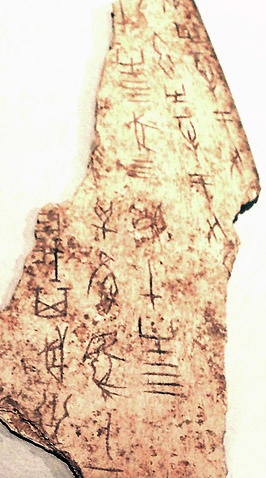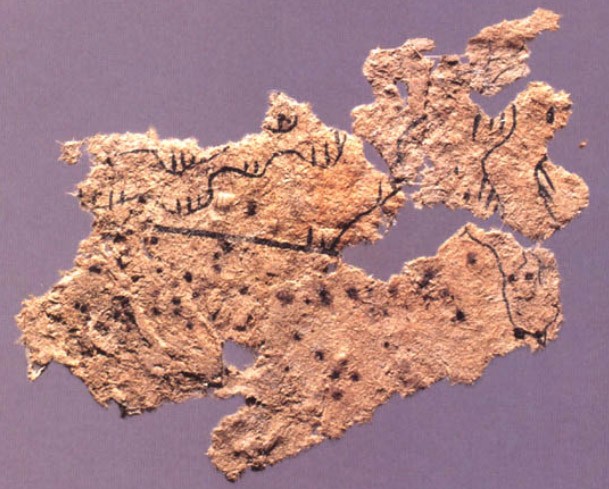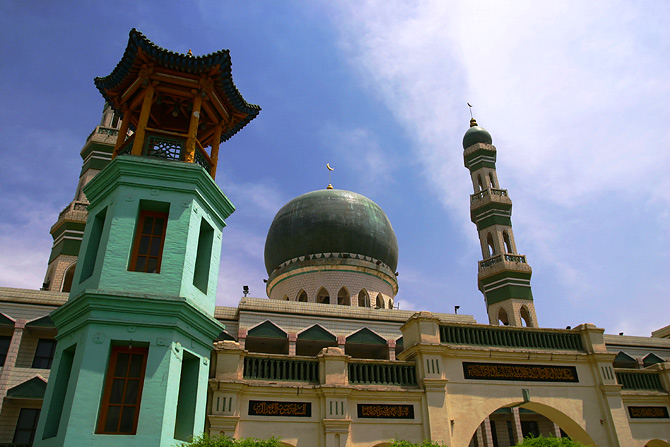|
Bamboo Slips
Bamboo and wooden strips ( zh, s=简牍, t=簡牘, first=t, p=jiǎndú) are long, narrow strips of wood or bamboo, each typically holding a single column of several dozen brush-written characters. They were the main media for writing documents in China before the widespread introduction of paper during the first two centuries AD. (Silk was occasionally used, for example in the Chu Silk Manuscript, but was prohibitively expensive for most documents.) Strips of wood or bamboo vary primarily in length. For bamboo manuscripts, the strips can go from as short as 9 cm to as long as 45 cm. The width is more consistently around 0.6 cm. The writing proceeds vertically, from right to left. Strips were bound together with hemp, silk, or leather and used to make a kind of folding book, called ''jiǎncè'' or ''jiǎndú''. The binding process usually takes place after the writing, with a few exceptions. The earliest surviving examples of wood and bamboo slips date from th ... [...More Info...] [...Related Items...] OR: [Wikipedia] [Google] [Baidu] |
Henan
Henan; alternatively Honan is a province in Central China. Henan is home to many heritage sites, including Yinxu, the ruins of the final capital of the Shang dynasty () and the Shaolin Temple. Four of the historical capitals of China, Luoyang, Anyang, Kaifeng and Zhengzhou, are in Henan. While the province's name means 'south of the river', approximately a quarter of the province lies north of the Yellow River. With an area of , Henan covers a large part of the fertile and densely populated North China Plain. Its neighboring provinces are Shaanxi, Shanxi, Hebei, Shandong, Anhui, and Hubei. Henan is China's third-most populous province and the most populous among inland provinces, with a population of over 99 million as of 2020. It is also the world's seventh-most populous administrative division; if it were a country by itself, Henan would be the 17th-most populous in the world, behind Egypt and Vietnam. People from Henan often suffer from regional discrimination ... [...More Info...] [...Related Items...] OR: [Wikipedia] [Google] [Baidu] |
Fangmatan
Fangmatan () is an archeological site located near Tianshui in China's Gansu province. The site was located within the Qin state, and includes several burials dating from the Warring States period through to the early Western Han. Tomb 1 The date of the burial of Tomb 1 was approximately 230 to 220 BCE at the very end of the Warring States period; it was excavated in 1986. The tomb contained a number of long-lost texts written on bamboo slips, including almanacs ( Rishu 日書), legal texts, medical works, and seven maps. The maps are drawn in black ink on four rectangular pieces of pine wood, 26.7 cm in length and between 15 and 18.1 cm in width, and depict the tributary river systems of the Jialing River in modern Sichuan Sichuan is a province in Southwestern China, occupying the Sichuan Basin and Tibetan Plateau—between the Jinsha River to the west, the Daba Mountains to the north, and the Yunnan–Guizhou Plateau to the south. Its capital city is ... [...More Info...] [...Related Items...] OR: [Wikipedia] [Google] [Baidu] |
Zhangjiashan Han Bamboo Texts
The Zhangjiashan Han bamboo texts are ancient Han dynasty Chinese written works dated 196–186 BC. They were discovered in 1983 by archaeologists excavating tomb no. 247 at Mount Zhangjia () of Jiangling County, Hubei Province (near modern Jingzhou). The tomb was built for an early Western Han era official who had died in 186 BC. The texts were written on traditional bamboo slips connected by cords into rolled scrolls. The written works included legal case precedents, literature on medicine including '' Book on Vessels'', mathematics, military strategy Military strategy is a set of ideas implemented by military organizations to pursue desired Strategic goal (military), strategic goals. Derived from the Greek language, Greek word ''strategos'', the term strategy, when first used during the 18th ..., and a calendar with dates ranging from 202 BC to 186 BC. The mathematical work found within the tomb, the '' Book on Numbers and Computation'', rapidly advanced the state of ... [...More Info...] [...Related Items...] OR: [Wikipedia] [Google] [Baidu] |
Qinghai
Qinghai is an inland Provinces of China, province in Northwestern China. It is the largest provinces of China, province of China (excluding autonomous regions) by area and has the third smallest population. Its capital and largest city is Xining. Qinghai borders Gansu on the northeast, Xinjiang on the northwest, Sichuan on the southeast and the Tibet Autonomous Region on the southwest. Qinghai province was established in 1928 during the period of the Republic of China (1912–1949), Republic of China, and until 1949 was ruled by Hui people, Chinese Muslim warlords known as the Ma clique. The Chinese language, Chinese name "Qinghai" is after Qinghai Lake, the largest lake in China. The lake is known as Tso ngon in Tibetan, and as Kokonor Lake in English, derived from the Mongol Oirat language, Oirat name for Qinghai Lake. Both Tso ngon and Kokonor are names found in historic documents to describe the region.Gangchen Khishong, 2001. ''Tibet and Manchu: An Assessment of Tibet-Man ... [...More Info...] [...Related Items...] OR: [Wikipedia] [Google] [Baidu] |
Shuanggudui
Shuanggudui () is an archeological site located near Fuyang in China's Anhui province. Shuanggudui grave no. 1, which belongs to Xiahou Zao (), the second marquis of Ruyin (), was sealed in 165 BCE in the early Han dynasty (206 BCE – 220 CE). Excavated in 1977, it was found to contain a large number of texts written on bamboo strips, including fragments of the '' Classic of Poetry'' and the '' Songs of the South'', a text on breathing exercises, a "year table" () recounting historical events, a manual on dogs, a version of the '' I Ching'' (''Yijing'') that differs from the received one, and artifacts including the oldest known cosmic board, a divinatory instrument. Like Mawangdui and Guodian, two other tombs from the area of the old state of Chu, the Shuanggudui find has shed great light on the culture and practices of the early Han dynasty. Excavation and identification Shuanggudui (, literally "paired ancient tumuli") was excavated in July 1977 during the expans ... [...More Info...] [...Related Items...] OR: [Wikipedia] [Google] [Baidu] |
Anhui
Anhui is an inland Provinces of China, province located in East China. Its provincial capital and largest city is Hefei. The province is located across the basins of the Yangtze and Huai rivers, bordering Jiangsu and Zhejiang to the east, Jiangxi to the south, Hubei and Henan to the west, and Shandong to the north. With a population of 61 million, Anhui is the 9th most populous province in China. It is the 22nd largest Chinese province based on area, and the 12th most densely populated region of all 34 Chinese provincial regions. Anhui's population is mostly composed of Han Chinese. Languages spoken within the province include Lower Yangtze Mandarin, Wu Chinese, Wu, Huizhou Chinese, Hui, Gan Chinese, Gan and small portion of Central Plains Mandarin. The name "Anhui" derives from the names of two cities: Anqing and Huizhou, Anhui, Huizhou (now Huangshan City). The abbreviation for Anhui is , corresponding to the historical , and is also used to refer to the Wan River and Mount Ti ... [...More Info...] [...Related Items...] OR: [Wikipedia] [Google] [Baidu] |
Qin Dynasty
The Qin dynasty ( ) was the first Dynasties of China, imperial dynasty of China. It is named for its progenitor state of Qin, a fief of the confederal Zhou dynasty (256 BC). Beginning in 230 BC, the Qin under King Ying Zheng engaged in a Qin's wars of unification, series of wars conquering each of the rival states that had previously pledged fealty to the Zhou. This culminated in 221 BC with the successful unification of China under Qin, which then assumed an imperial prerogativewith Ying Zheng declaring himself to be Qin Shi Huang, the first emperor of China, and bringing an end to the Warring States period (221 BC). This state of affairs lasted until 206 BC, when the dynasty collapsed in the years following Qin Shi Huang's death. The Qin dynasty's 14-year existence was the shortest of any major dynasty in Chinese history, with only two emperors. However, the succeeding Han dynasty (202 BC220 AD) largely continued the military and administ ... [...More Info...] [...Related Items...] OR: [Wikipedia] [Google] [Baidu] |
Hubei
Hubei is a province of China, province in Central China. It has the List of Chinese provincial-level divisions by GDP, seventh-largest economy among Chinese provinces, the second-largest within Central China, and the third-largest among inland provinces. Its provincial capital at Wuhan serves as a major political, cultural, and economic hub for the region. Hubei is associated with the historical state of E that existed during the Western Zhou dynasty (771 BCE). Its name means 'north of the lake', referring to Dongting Lake. It borders Henan to the north, Anhui and Jiangxi to the east, Hunan to the south, and Chongqing and Shaanxi to the west. The high-profile Three Gorges Dam is located at Yichang in the west of the province. History The Hubei region was home to sophisticated Neolithic cultures. By the Spring and Autumn period (770–476 BC), the territory of today's Hubei formed part of the powerful Chu (state), State of Chu. Chu, nominally a tributary state of the Zh ... [...More Info...] [...Related Items...] OR: [Wikipedia] [Google] [Baidu] |
Shuihudi Qin Bamboo Texts
The Shuihudi Qin bamboo texts () are early Chinese texts written on bamboo slips, and are also sometimes called the Yúnmèng Qin bamboo texts. They were excavated in December 1975 from Tomb #11 at Shuìhǔdì () in Yunmeng County, Hubei, China. The tomb belonged to a Qin administrator 217 BCE. Written in the Qin dynasty, the texts record Qin laws and public documents. Their contents have been published in the book 《睡虎地秦墓竹簡》 (''Shuìhǔdì Qínmù Zhújiǎn''). This cache of bamboo slips is of great importance for research into the government, economics, culture, law, military affairs, etc. of the late Warring States to the Qin period. While the Shuihudi cache is deemed to be among the most valuable epigraphic sources on the Qin history, the discoveries of the Qin Slips of Liye in 2002 and 2005 are regarded as being of equal, if not bigger, importance. Yuri Pines, Gideon Shelach, Lothar von Falkenhausen, Robin D. S. Yates (eds.). Birth of an Empire:The S ... [...More Info...] [...Related Items...] OR: [Wikipedia] [Google] [Baidu] |
Hebei
Hebei is a Provinces of China, province in North China. It is China's List of Chinese administrative divisions by population, sixth-most populous province, with a population of over 75 million people. Shijiazhuang is the capital city. It borders Shanxi to the west, Henan to the south, Shandong and Liaoning to the east, and Inner Mongolia to the north; in addition, Hebei entirely surrounds the direct-administered municipalities of Beijing and Tianjin on land. Its population is 96% Han Chinese, 3% Manchu people, Manchu, 0.8% Hui people, Hui, and 0.3% Mongols in China, Mongol. Varieties of Chinese spoken include Jilu Mandarin, the Beijing dialect of Mandarin, and Jin Chinese. During the Spring and Autumn period, Spring and Autumn and Warring States periods (771–226 BC), the region was ruled by the states of Yan (state), Yan and Zhao (state), Zhao. During the Yuan dynasty (1271–1368), the region was called Zhongshu Sheng, Zhongshu. It was called North Zhili during the ... [...More Info...] [...Related Items...] OR: [Wikipedia] [Google] [Baidu] |
Shandong
Shandong is a coastal Provinces of China, province in East China. Shandong has played a major role in Chinese history since the beginning of Chinese civilization along the lower reaches of the Yellow River. It has served as a pivotal cultural and religious center for Taoism, Chinese Buddhism and Confucianism. Shandong's Mount Tai is the most revered mountain of Taoism and a site with one of the longest histories of continuous religious worship in the world. The Buddhist temples in the mountains south of the provincial capital of Jinan were once among the foremost Buddhist sites in China. The city of Qufu was the birthplace of Confucius, and later became the center of Confucianism. Shandong's location at the intersection of ancient and modern north–south and east–west trading routes has helped establish it as an economic center. After a period of political instability and economic hardship beginning in the late 19th century, Shandong has experienced rapid growth in recent de ... [...More Info...] [...Related Items...] OR: [Wikipedia] [Google] [Baidu] |







